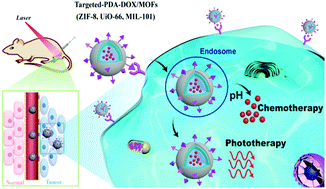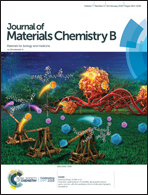Stimuli-responsive multifunctional metal–organic framework nanoparticles for enhanced chemo-photothermal therapy†
Abstract
Construction of stimuli-responsive multifunctional nanoparticles is critical for nanotherapeutic delivery. Though metal–organic frameworks (MOFs) have been emerged as promising delivery vehicles, the therapeutic efficacy of MOFs in cancer treatment is limited by the lack of a general approach for the preparation of stimuli-responsive multifunctional MOFs. We show that the combination of a versatile coating material polydopamine with MOFs enables facile integration of different functional therapeutics, obtaining stimuli-responsive multifunctional MOFs with extensive photothermal efficiency and outstanding capability to abrogate tumors by chemo-photothermal therapy. Exemplary MOFs including ZIF-8, UiO-66, and MIL-101 were utilized to prepare stimuli-responsive multifunctional MOFs to illustrate the generality of the strategy. This approach enables targeted drug delivery and stimuli-responsive release of multi-therapeutics and allows combination therapy with excellent in vitro and in vivo antitumor activity. Taking into account the diversity of MOFs and different functional molecules, this work provides flexible access to programmable MOF nanoparticles for specific biological applications.



 Please wait while we load your content...
Please wait while we load your content...